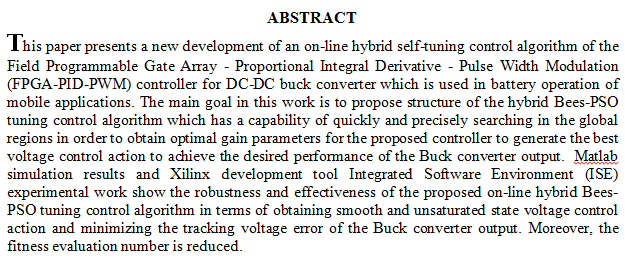
In the current endeavor, a new Schiff base of 14,15,34,35-tetrahydro-11H,31H-4,8-diaza-1,3(3,4)-ditriazola-2,6(1,4)-dibenzenacyclooctaphane-4,7-dien-15,35-dithione was synthesized. The new symmetrical Schiff base (Q) was employed as a ligand to produce new complexes comprising Co(II), Ni(II), Cu(II), Pd(II), and Pt(II) metal-ions at a ratio of 2:1 (Metal:ligand). There have been new ligands and their complexes validated by (FTIR), (UV-visible), 1H-NMR, 13C-NMR, CHNS, and FAA spectroscopy, Thermogravimetric analysis (TG), Molar conductivity, and Magnetic susceptibility. The photostabilization technique to enhance the polymer was also used. The ligand Q and its complexes were mixed in 0.5% w/w of polyvinyl chloride in tetrahydrofuran
... Show MoreIn a hybrid cooling solar thermal systems , a solar collector is used to convert solar energy into heat energy in order to super heat the refrigerant leaving the compressor, and this process helps in the transformation of refrigerant state from gaseous state to the liquid state in upper two-thirds of the condenser instead of the lower two-thirds such as in the traditional air-conditioning systems and this will reduce the energy needed to run the process of cooling .In this research two systems with a capacity of 2 tons each were used, a hybrid air-conditioning system with an evacuated tubes solar collector and a traditional air-conditioning system . The refrigerant of each type was R22.The comparison was in the amou
... Show More The reaction of L-ascorbic acid with the tirchloroacetic acid in the presence of potassium hydroxide gave new product Bis[O,O-2,3;O,O-5,6(chlorocarboxylicmethyliden)]Lascorbic acid (H2L) which was isolated and characterized by 1H,13C-NMR, elemental analysis (C,H,N), UV-Visible and Fourier Transform Infrared (FTIR). The complexes of the ligand (H2L) with metal ions, M+2= (Cu, Co, Ni, Cd and Hg) were synthesized and characterized by FTIR, UV-Visible, molar conductance, atomic absorption, magnetic susceptibility and the molar ratio. The analysis evidence showed the binding of the metal ions with (H2L) through the bicarboxylato group manner resulting in six-coordinated metal ion. The TLC for (H2L) and complexes showed one spot for eac
... Show MoreAbstract: Iatrogenic furcal root perforations are serious complications during dental treatment. This study was aimed to compare the sealing ability of new bioceramic root repair material TotalFill® with the other perforation repair materials (GIC, MTA and Biodentine) using a dye- extraction method.Materials and Methods: Forty extracted, human mandibular molars with non-fused well developed root were collected. Artificial perforations were made from the external surface of the teeth. Then the teeth were randomly divided into 4 experimental groups (n= 10) according to the type of repair material used in this study; Medifil glass ionomercement, TotalFill® bioceramic root repair material, BiodentineTM and MTA Plus. The specimens were then im
... Show MoreMixed ligand metal complexes of CrIII, FeIII,II, NiII and CuII have been synthesized using 5-chlorosalicylic acid (5-CSA) as a primary ligand and L-Valine (L-Val) as secondary ligand. The metal complexes have been characterized by elemental analysis, electrical conductance, magnetic susceptibility measurements and spectral studies. The electrical conductance studies of the complexes indicate their electrolytic nature. Magnetic susceptibility measurements revealed paramagnetic nature of the all complexes. Bonding of the metal ion through –OHand –COOgroups of bidentate to the 5-chlorosalicylic acid and through –NH2 and –COOgroups of bidentate to the L-valine by FT-IR studies . The agar diffusion method has been used to study the antib
... Show MoreThe goal of this investigation is to prepare zinc oxide (ZnO) nano-thin films by pulsed laser deposition (PLD) technique through Q-switching double frequency Nd:YAG laser (532 nm) wavelength, pulse frequency 6 Hz, and 300 mJ energy under vacuum conditions (10-3 torr) at room temperature. (ZnO) nano-thin films were deposited on glass substrates with different thickness of 300, 600 and 900 nm. ZnO films, were then annealed in air at a temperature of 500 °C for one hour. The results were compared with the researchers' previous theoretical study. The XRD analysis of ZnO nano-thin films indicated a hexagonal multi-crystalline wurtzite structure with preferential growth lines (100), (002), (101) for ZnO nano-thin films with different thi
... Show More (2)
(2)
Multiple eliminations (de-multiple) are one of seismic processing steps to remove their effects and delineate the correct primary refractors. Using normal move out to flatten primaries is the way to eliminate multiples through transforming these data to frequency-wavenumber domain. The flatten primaries are aligned with zero axis of the frequency-wavenumber domain and any other reflection types (multiples and random noise) are distributed elsewhere. Dip-filter is applied to pass the aligned data and reject others will separate primaries from multiple after transforming the data back from frequency-wavenumber domain to time-distance domain. For that, a suggested name for this technique as normal move out- frequency-wavenumber domain
... Show More (1)
(1)
Pure and Fe-doped zinc oxide nanocrystalline films were prepared
via a sol–gel method using -
C for 2 h.
The thin films were prepared and characterized by X-ray diffraction
(XRD), atomic force microscopy (AFM), field emission scanning
electron microscopy (FE-SEM) and UV- visible spectroscopy. The
XRD results showed that ZnO has hexagonal wurtzite structure and
the Fe ions were well incorporated into the ZnO structure. As the Fe
level increased from 2 wt% to 8 wt%, the crystallite size reduced in
comparison with the pure ZnO. The transmittance spectra were then
recorded at wavelengths ranging from 300 nm to 1000 nm. The
optical band gap energy of spin-coated films also decreased as Fe
doping concentra
 (1)
(1)
 (3)
(3)
 (2)
(2)
The biological activities of some ternary nickel complexes with a Schiff base obtained from 4-dimethylaminobenzaldehyde and 2-aminophenol have been reported. The Schiff base ( HL1) acts as a primary ligand whereas, anthranilic acid ( HL2), 2-nitroaniline ( HL3), alanine ( HL4) and histidine ( HL5) act as secondary ligand or co-ligand. The anticancer activity of these compounds was studied against human colon carcinoma (HCT-116), human hepatocellular liver carcinoma (HEPG-2) and human breast carcinoma (MCF-7) cell lines. As per the results, the compounds were active against the cell lines. The antioxidant activity of the same compounds was evaluated using DPPH (1,1-diphenyl-2-picryl-hydrazyl) radical scavenging and compared with ascorbic aci
... Show More